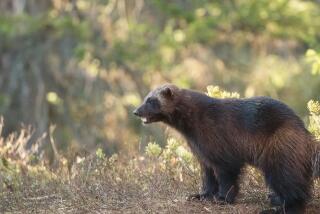Grizzly Bear Debate About to Rear Up
- Share via
BOZEMAN, Mont. — How many grizzly bears are there, and how many are enough?
Those deceptively simple questions are at the heart of a brewing fight over what is likely to be one of the government’s most controversial wildlife decisions since the Endangered Species Act became law in 1973: whether the grizzly bear population in and around Yellowstone National Park should be taken off the threatened-species list and its management handed over to the states of Wyoming, Montana and Idaho.
Nearly a quarter of a century after the government extended protection to the reclusive and sometimes menacing creature that symbolizes North American wilderness, federal scientists and bear managers are cautiously negotiating the bureaucratic steps that would result in a declaration of victory for one of only two large grizzly populations remaining in the lower 48 states.
Sometime early next year, they will seek public comment on a conservation strategy that would guide bear management after delisting, and perhaps by late 1999 formally propose to declare the Yellowstone bears recovered.
For the Clinton administration, eager to demonstrate that the Endangered Species Act works--although just 11 species have been taken off the list in 25 years--it would be a major environmental trophy. But when it comes to the grizzly bear, whose need for big chunks of wild country and inability to coexist with people are unsurpassed, consensus among the biologists, federal and state agencies, politicians, economic interests and conservation groups that have a stake in its management is almost always impossible.
Some environmentalists accuse the government of caving in to politicians who favor delisting in the belief that it will mean fewer restrictions on commercial use of federal forest and range land abutting Yellowstone. And biologists argue among themselves about how much the bear population has increased and what kind of long-term future the species has, given human pressures on the lands surrounding Yellowstone.
Chris Servheen, a U.S. Fish and Wildlife Service biologist who heads the government grizzly bear recovery program, estimates that 400 to 600 grizzly bears live in and around Yellowstone and that the population is growing 4% to 5% a year. That is more than twice as many bears as at the time the species was listed and the park abruptly decided to close the garbage dumps that many bears depended on, an action that resulted in the deaths of scores of grizzlies but weaned them from dependence on human food.
But David Mattson, a prominent bear researcher working with the U.S. Geological Survey, strongly disagrees with Servheen. In a paper he co-wrote that is scheduled to be published in the journal Ecology, Mattson wrote that “the Yellowstone grizzly bear population changed little from 1975 to 1995” and that fluctuations in the population had more to do with cycles in a key food source--whitebark pine nuts--than with government protections.
The recent dispersal of bears into areas where they have been absent for decades, said Mattson, could indicate that the bears are frantically searching for new sources of food to replace ones in decline. He cites the drop in whitebark pines due to the 1988 Yellowstone fires and the growing threat of a pine disease called blister rust.
Pine nuts are an important fall food source for grizzlies as they pack on fat for the winter. Because whitebark pine is a high-elevation species, this food source also helps bears avoid the kind of conflicts with people that are the prime cause of their mortality.
Skeptics also cite the escalating threat of private land development in the Yellowstone ecosystem, which includes some of the fastest-growing counties in the United States, and the specter of oil and gas development in the Shoshone and Bridger-Teton national forests once federal protections for the grizzly are lifted.
But other environmental groups are holding their fire. Hank Fischer, northern Rockies representative for Defenders of Wildlife, says that “what a lot of people don’t get is when the bear is delisted it doesn’t mean protection goes away. The whole intent of the Endangered Species Act is to take the protections that are afforded by the act and transfer them at the time of delisting to the states and other entities.”
More to Read
Sign up for Essential California
The most important California stories and recommendations in your inbox every morning.
You may occasionally receive promotional content from the Los Angeles Times.













